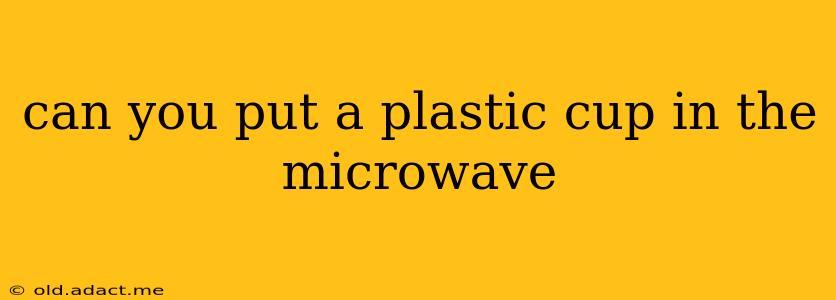Can You Put a Plastic Cup in the Microwave? A Comprehensive Guide
The short answer is: it depends. Not all plastic cups are microwave-safe. Putting the wrong type of plastic in the microwave can lead to melting, warping, or even releasing harmful chemicals into your food. This guide will help you understand which plastics are safe and which ones to avoid.
What Makes a Plastic Microwave-Safe?
The key is identifying the type of plastic. Look for a small number usually enclosed within a triangle symbol on the bottom of the cup. This number represents the resin identification code (RIC). Only plastics marked with a #5 (polypropylene) or a #7 (other, but sometimes includes BPA-free plastics) are generally considered safe for microwave use. Even then, always check the manufacturer's instructions.
Important Note: Even if the plastic is labeled as microwave-safe, it's crucial to follow these precautions:
- Avoid extremely hot temperatures and long heating times. Prolonged exposure to high heat can still cause the plastic to degrade over time, even if it's labeled microwave-safe.
- Don't fill the cup to the brim. Leave some space for steam to escape, preventing potential spills or pressure buildup.
- Inspect the cup before each use. Check for any cracks, warping, or signs of damage. If you see any, discard the cup immediately.
What Happens If You Microwave the Wrong Type of Plastic?
Microwaving non-microwave-safe plastics can result in several undesirable consequences:
- Melting: The plastic may begin to melt or deform, potentially contaminating your food.
- Chemical Leaching: Certain plastics can release harmful chemicals into your food when heated, posing health risks. This is especially concerning with plastics containing BPA (bisphenol A), which has been linked to various health problems.
- Warping: The plastic cup may warp or change shape, making it unusable.
- Fire Hazard: In rare cases, excessive heating of inappropriate plastics can lead to a fire hazard.
Which Plastics Should You NEVER Microwave?
Avoid microwaving plastics marked with the following RIC numbers:
- #1 (PET or PETE): Polyethylene terephthalate, commonly used for soda bottles. Not designed for repeated heating.
- #2 (HDPE): High-density polyethylene, often used for milk jugs. While generally considered safe for cold storage, it's not recommended for microwaving.
- #3 (PVC): Polyvinyl chloride, often found in cling film. Absolutely avoid microwaving PVC; it can release harmful chemicals.
- #4 (LDPE): Low-density polyethylene, used for plastic bags and some food wraps. Not suitable for microwave use.
- #6 (PS): Polystyrene, used for disposable cups and plates. Should not be microwaved as it can leach chemicals.
Can I Microwave a Plastic Cup with a Lid?
Ideally, no. Many plastic lids are not microwave-safe, even if the cup itself is. Remove the lid before microwaving to avoid potential melting or warping. If the lid is specifically labeled as microwave-safe, you can use it at your own risk, but carefully monitor the process.
What are Some Microwave-Safe Alternatives to Plastic Cups?
Consider switching to microwave-safe alternatives like:
- Glass: Glass cups are excellent microwave-safe options.
- Ceramic: Ceramic mugs are also a great alternative.
- Microwave-safe silicone: Some silicone cups and containers are specifically designed for microwave use and are often more durable and flexible than plastic.
By carefully checking the RIC number and following these guidelines, you can ensure the safe and efficient use of your microwave with plastic cups. Remember, safety should always be your priority.
